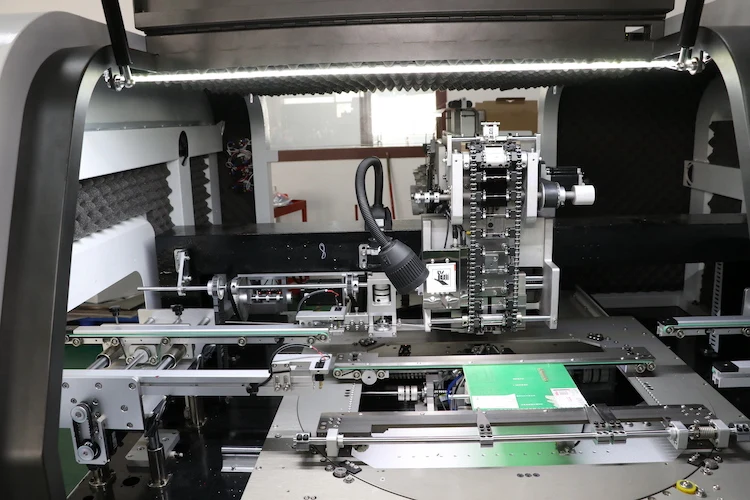Component Auto Insertion Machines
Component auto insertion machines are specialized equipment used in the electronics manufacturing industry to automate the process of inserting electronic components onto printed circuit boards (PCBs). These machines are designed to handle various types of components based on their physical characteristics and application requirements. Below is a detailed overview of the three main types, along with additional insights on technological advancements, industry applications, and market trends.

1. Radial Insertion Machine
A Radial Insertion Machine is specifically designed for components with leads that extend radially from the body’s perimeter. Commonly used for capacitors, resistors, and diodes, these machines feature multiple dispensing heads that can accommodate different component types. They allow for adjustments in clinch lead angle, ensuring proper seating and forming of the leads on the PCB.
Innovations and Applications:
- Machine Vision Systems: Modern radial insertion machines often include high-precision vision systems (like CCD cameras) that detect component polarity and lead bending in real-time, optimizing the insertion path and reducing calibration time.
- Industry Relevance: Vital in producing polarity-sensitive components for automotive and lighting industries, where manufacturers face increasing demands for LED assemblies.
Recommended style: HWR-20
- Instead of labor work, achieve highly efficient production.
- Theoretical UPH is up to 24000 points/hour.
- Simple operation, high stability, high accuracy.
- It can be used to place a wide variety of components, it’s more flexibility for products.
- Bottom maintenance cost.
- The sturdy structural design easily overcomes the moments generated by high-speed motion and the stability disturbances caused by mechanical stress, so that it can comfortably cope with the high-efficiency operating rhythm of the production line and maintains the stability of operation for a long period of time.
2. Axial Insertion Machine
An Axial Insertion Machine targets components with leads extending from one end, such as axial resistors and capacitors. The design focuses on inserting components with precise lead placement, and automated feeders allow for continuous operation, minimizing manual involvement.
Key Features:
- Insertion Accuracy: Machines typically achieve insertion precision of ±0.05mm and can handle a variety of component sizes.
- Industry Usage: Important for standardizing mass production with rigorous quality assurance in sectors like telecommunications and consumer electronics.
Recommended style: HWR-30
This automated insertion machine is designed for the process of placing axial components in PCB assembly lines.
The theoretical speed of HWR-30 axial insertion machine is up to 24000UPH, making an efficient production, shorter changeover time, it can realize the fully automatic production line, also allows the traceability of operations, and connects to the factory’s system.
We have all solutions for inserting radial, axial, pin, terminal, connector, and odd form components, it’s appreciated to contact us for getting more insertion machines catalogue.
3. Odd-form Insertion Machine
Odd-form Insertion Machines cater to components that do not conform to the radial or axial lead configurations, like connectors, switches, and transformers. These machines are adaptable and often feature customizable tooling to handle unique geometries.
Technical Advancements:
- Precision Mechanisms: They incorporate systems that accurately position and insert components at non-standard angles or depths.
- Versatility: Ideal for applications requiring a mix of standard and specialized components, enhancing production flexibility.
Recommended style: HWR-30
- Instead of manual work, save labor cost.
- Compact machine size can be easily integrated into SMT production line.
- Theoretical speed up to 6000 points/hour, high efficiency, and productivity.
- Simple operation, easy programmed, stable, and reliable.
- Flexible deployment of production
- Bottom maintenance cost.
- Modular design according to different feeding methods to provide various feeding solutions. According to production requirements to provide flexible configuration, to meet pin components, irregular components of continuous feeding.
- Grippers and nozzles can be customized for various types of shaped components, easy for replacement.
- Windows based software, full English interface, easy to operate.
Additional Insights
Technological Innovations
- AI Integration: Some machines utilize AI algorithms for adaptive handling of slightly deformed components, minimizing scrap rates.
- Flexible Manufacturing: Machines with modular designs allow for quick fixture and nozzle changes, accommodating small batches and varied productions.
Industry Applications and Challenges
- Emerging Fields: Adaptations for high-frequency PCBs in 5G technology, which require low-stress insertion techniques to prevent signal interference.
- Operation Pain Points: Frequent calibration needs for high-precision machines and the reliability of consumables like nozzles and fixtures.

Market Trends
- Growth in Demand: The global PCB insertion equipment market reached $1.8 billion in 2023, with a projected growth of 26% driven by automotive electronics, particularly in EVs.
- Sustainability Focus: Innovations such as servo motors replacing pneumatic systems have reduced energy consumption by 40%.
Comparative Overview
| Dimension | Radial Insertion Machine | Axial Insertion Machine | Odd-form Insertion Machine |
|---|---|---|---|
| Typical Components | Radial electrolytic capacitors, LEDs | Axial resistors, diodes | Connectors, transformers |
| Precision Requirement | Medium (±0.1mm) | High (±0.05mm) | Custom (±0.02~0.2mm) |
| Production Compatibility | Suitable for large-volume single components | Medium-volume standardized production | Small-batch mixed production |
| Upgrade Cost | Low (high modularity) | Medium | High (custom tooling needed) |
| Leading Manufacturers | Universal Instruments | Juki | Mycronic |
Case Studies
- Automotive ECU Production:
- Challenge: Inserting high-temperature components (like 125°C rated capacitors) necessitates PCB pre-heating to prevent lead loosening.
- Solution: Integrating localized heating modules into radial machines to maintain temperature control within ±2°C.
- Wearable Device Miniaturization:
- Challenge: Inserting Micro-USB connectors with a 0.5mm pitch requires extreme precision.
- Solution: Employing odd-form machines with piezoelectric ceramics for nano-level adjustments.
tag:Component Auto Insertion Machines



